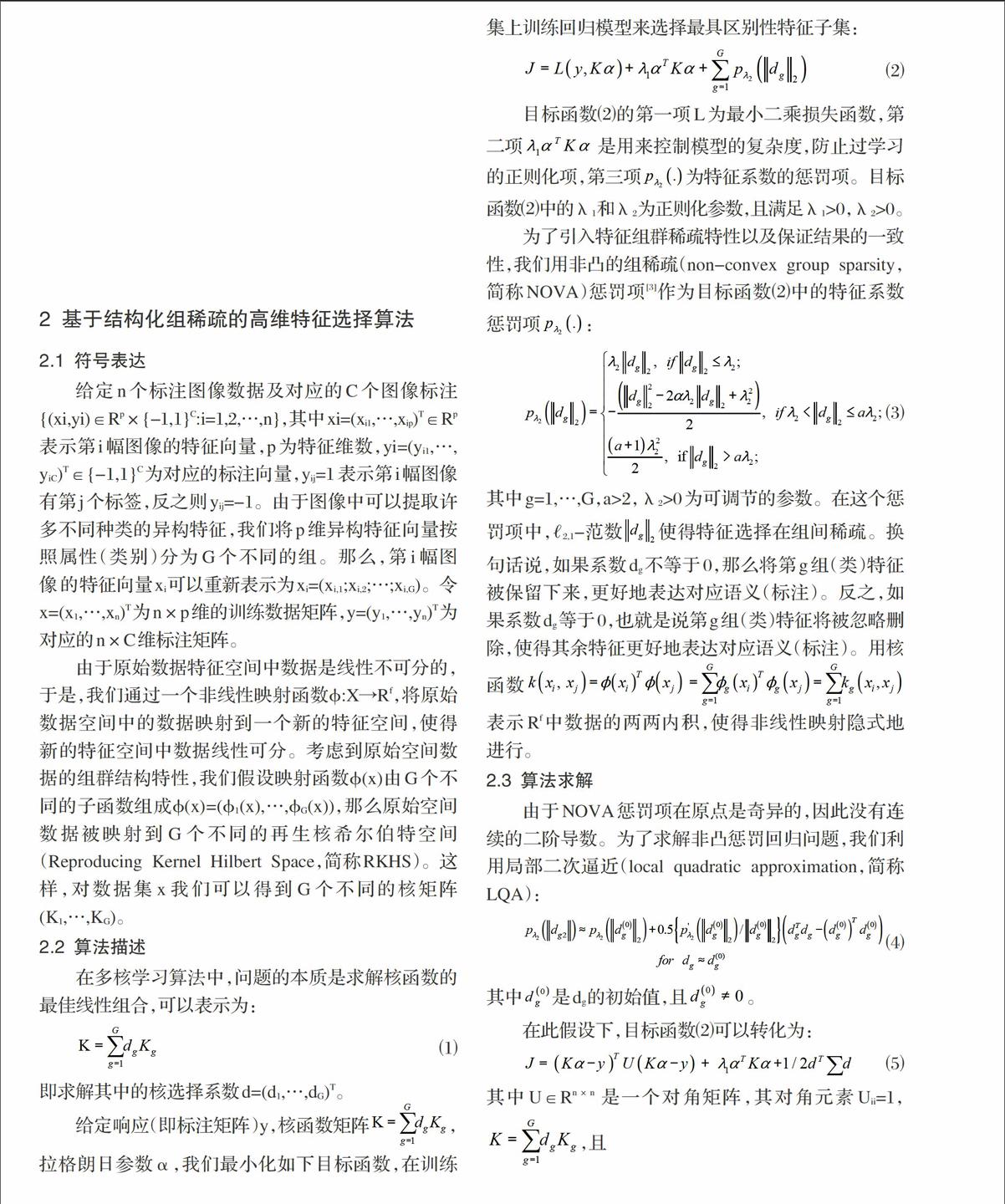基于结构化组稀疏的图像标注
2016-10-28袁莹
袁莹


DOI:10.16644/j.cnki.cn33-1094/tp.2016.09.005
摘 要: 图像中存在颜色、形状和纹理等全局特征以及LBP和SIFT等局部特征,这些异构特征之间存在明显的结构信息。不同视觉特征在表示特定高层语义时重要程度不同,因此,正确的特征选择对于图像标注来说具有十分重要的意义。为了充分利用异构特征之间的结构组效应,提出了一种基于组稀疏的高维特征选择算法及其在图像标注中的应用。通过与其他三种算法在图像标注上的性能对比,证明该算法能得到更优的图像标注结果。
关键词: 异构特征; 组稀疏; 特征选择; 图像标注
中图分类号:TP311 文献标志码:A 文章编号:1006-8228(2016)09-17-04
Image annotation based on structured grouping sparsity
Yuan Ying
(Department of Computer and Information Technology, ZheJiang Police College, Hangzhou, Zhejiang 310058, China)
Abstract: The heterogeneous features can describe various aspects of visual characteristics of images, such as global features (color, shape and texture) or local features (SIFT and LBP). Different heterogeneous features have different structural information. Different groups of heterogeneous features have different intrinsic discriminative power to characterize the semantics inside images. Therefore, to select the right features is of great significance for image annotation. In order to effectively utilize the structural grouping effect among heterogeneous visual features, a high-dimensional feature selection method based on structured grouping sparsity is proposed, and its application in image annotation is introduced. Comparing with the performance of other three algorithms in image annotation, it is proved that the proposed algorithm can get better image annotation results.
Key words: heterogeneous features; group sparsity; feature selection; image annotation
0 引言
随着数字摄影、网络技术、存储技术的迅速发展,互联网中的图像数据大量涌现。许多互联网网站如Flickr以及Wikipidia,提供用户免费上传、储存、分享照片,同时将图片标上标签以供浏览、查询。这些网站每天都在不断产生和使用海量的图像数据且伴随有大量文本信息,例如标注信息。然而这些标注信息往往是混乱无序的,同时还存在不少错误。这些图像数据在给人们生活带来各种便利的同时,也使用户如何能够从图像数据中快速准确地找到所需要的信息成为了一个迫切需要解决的课题。因此如何正确标注图像具有十分重要的意义。
1 稀疏表达概述
近年来,从统计信号处理中发展出的压缩感知(Compressive Sensing,简称CS)受到越来越多的关注。压缩感知利用“数据是稀疏可压缩”先验知识进行信号重建。压缩感知(Compressed sensing) 和特征选择(Feature selection)理论与方法相结合,用来对图像形成更加有效的“稀疏表达”(Sparse representation),成为计算机视觉和机器学习等领域的研究热点问题。美国斯坦福大学的Tibshirani 和加州大学伯克利分校的Breiman几乎同时提出了对特征系数施以?1-范数约束的lasso(least absolute shrinkage and selection operator)思想[1-2],促使被选择出来的特征尽可能稀疏,以保证结果稳定性和提高数据处理过程的可解释性(interpretable)。但是,以lasso为基础的特征选择方法并没有考虑到特征之间存在的组效应(grouping effect)特性(即某一(类)特征与其他(类)特征之间存在很强相关性)。
为了克服这一不足,本文利用异构特征所存在的组稀疏(grouping sparsity)特点去选择某一语义所对应的重要特征,提出了一种基于结构化组稀疏的高维特征选择算法(high-dimensional feature selection methods based on Structured Grouping Sparsity,简称SGS)。
4 结束语
本文将同一种类视觉特征归属为一组(如SIFT 特征归属为一组,而颜色直方图归属为另一组),使得图像异构特征在表达时能充分利用这种结构性组效应。同时,为了克服数据高维异构特征带来的线性不可分问题,本章提出了一个基于结构化组稀疏的高维特征选择图像标注算法(high-dimensional feature selection methods based on Structured Grouping Sparsity,简称SGS)。本文通过与其他三种算法在图像标注上的性能对比,证明了所提出算法SGS 能得到更优的图像标注结果。
但是在高维特征上的基于核学习的算法需要将数据通过核函数映射到新的特征空间,映射后的核矩阵维数只跟样本数量有关,因此对于大规模图像数据,核学习算法运行较慢,且无法满足随时增长的图像标注问题。如何建立大规模图像数据的学习模型以及如何处理实时增长的图片数据,是图像标注领域值得研究的重要问题。
参考文献(References):
[1] Robert Tibshirani. Regression shrinkage and selection via
the lasso. Journal of the Royal Statistical Society. Series B (Methodological),1996:267-288
[2] Leo Breiman. Heuristics of instability and stabilization in
model selection. The annals of statistics,1996.24(6):2350-2383
[3] F. Wu, Y. Yuan, Y. Rui, S. Yan, Y. Zhuang. Annotating
web images using nova: Non-convex group sparsity. In Proceedings of the 20th ACM international conference on Multimedia,2012:509-518
[4] Alexander Loui, Jiebo Luo, Shih-Fu Chang, Dan Ellis, Wei
Jiang, Lyndon Kennedy, Keansub Lee, Akira Yanagawa. Kodak's consumer video benchmark data set: concept definition and annotation. In Proceedings of the international workshop on Workshop on multimedia information retrieval,2007:245-254
[5] Hao Li, Meng Wang, Xian-Sheng Hua. Msra-mm 2.0: A
large-scale web multimedia dataset. In Data Mining Workshops, 2009. ICDMW'09. IEEE International Conference on,2009:164-169
[6] Tat-Seng Chua, Jinhui Tang, Richang Hong, Haojie Li,
Zhiping Luo, Yantao Zheng. Nus-wide: a real-world web image database from national university of singapore. In Proceedings of the ACM International Conference on Image and Video Retrieval,2009:48
[7] M. Yuan and Y. Lin. Model selection and estimation in
regression with grouped variables. Journal of the Royal Statistical Society: Series B (Statistical Methodology),2006.68(1):49-67
[8] Ying Yuan, Jian Shao, Fei Wu, Yue-Ting Zhuang. Image
annotation by the multiple kernel learning with group sparsity effect. Ruanjian Xuebao/Journal of Software,2012.23(9):2500-2509
